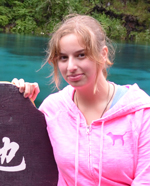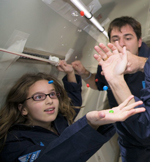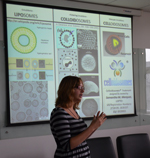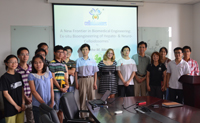Samantha Marquez
We are excited to introduce Samantha Marquez, a junior at Maggie L. Walker Governor's School for Government and International Studies in Richmond, Virginia. Her serious interest in science began at age 10 and has been fostered by her parents, both scientists and researchers, ever since. This past spring, Samantha competed at the Intel International Science and Engineering Fair (ISEF) and with her innovative "Celloidosomes®," took first place in her category for the second year in a row. We are proud to count Samantha as one the youngest scientists to meet the requirements of membership in Sigma Xi's history.
junior at Maggie L. Walker Governor's School for Government and International Studies in Richmond, Virginia. Her serious interest in science began at age 10 and has been fostered by her parents, both scientists and researchers, ever since. This past spring, Samantha competed at the Intel International Science and Engineering Fair (ISEF) and with her innovative "Celloidosomes®," took first place in her category for the second year in a row. We are proud to count Samantha as one the youngest scientists to meet the requirements of membership in Sigma Xi's history.
Tell us about your educational background including your doctoral research, if applicable.
This interview might differ from the others in the series in that I am actually still a high school student. I am a junior at Maggie L. Walker Governor's School for Government and International Studies in Richmond, Virginia. Even though I haven't been living for too long, I started having a deep interest in science very early on, when I was around 10 or 11 years old and have been conducting research ever since.
series in that I am actually still a high school student. I am a junior at Maggie L. Walker Governor's School for Government and International Studies in Richmond, Virginia. Even though I haven't been living for too long, I started having a deep interest in science very early on, when I was around 10 or 11 years old and have been conducting research ever since.
Do you have a particular teacher or professor who inspired your love of science? Why?
Even though I've had a passion for science since a very early age, I've had the honor and privilege of having the support and dedication from several teachers since then, especially at Robious Middle School and, currently, Maggie L. Walker Governor's School. At the same time, I think it's not only the vital teachers who make a difference, but also the system. The system itself embraces, encourages, and promotes each and every student to explore. Maggie L. Walker Governor's School has allowed me the freedom to grow as a student, a leader, a scientist, and a community member, and provided me with the tools necessary to succeed in any field I may choose. It is less about the grade and more about the learning experience you get from each class and teacher. Mrs. Stephanie Estes from Robious Middle School, my science teacher for two years, was an early influence on my choice to conduct research and I have her to thank for supporting me and believing in me from the very beginning. I am forever grateful for the opportunities and experience the school and, especially, the teachers have given me.
What is the focus of your current research?
Over the last three years, I have pioneered a revolutionary cell-architecture process for the design and engineering of core/shell multicellular structures based on a "bottom-up strategy". This unique 3D organized cell structure is, by definition, a "living capsule" with a biomembrane/tissue shell and a unique core that acts as container or reservoir. I call it: Celloidosomes®.
revolutionary cell-architecture process for the design and engineering of core/shell multicellular structures based on a "bottom-up strategy". This unique 3D organized cell structure is, by definition, a "living capsule" with a biomembrane/tissue shell and a unique core that acts as container or reservoir. I call it: Celloidosomes®.
Microbiological methods, using Petri dishes, are the standard method used to organize cells into living 2D tissue. More sophisticated tissue structures are presently possible using scaffolding that promotes 3D cell organization. In Cell-Delivery technologies, clusters of cells (islets) have been used for restoration of cell function after transplantation (i.e. pancreatic islets); however these islets are extremely sensitive to oxygen deficiency and, because of hypoxia, the transplanted islets subsequently die. There is an evident need for novel multicellular structures that can overcome the oxygen transport limitations presented in the current islets. A potential solution to this problem is my core/shell multicellular assembly-system: Celloidosomes®.
I have developed a novel method of cellular architecture that I demonstrated by designing and bioengineering two new Celloidosomes. The first consists of cooperation between HEP G-2 and fibroblast cells that mimics the structure and functionality of a liver gland. This is a bottom-up tissue engineering approach to organ reconstruction and tissue regeneration. The second, the Neuro-Celloidosome (NC), represents the first evidence of the formation of neural networks in 3D independent units that, by cooperation, extend their axon/dendrite connections to other NC's. The synchronized oscillations between NC's had a higher frequency than that reported for 2D neural networks, suggesting that our NC's have larger number of synapses with promising potential in the functionality of the use of the neural tissue for transplantation. Because of the core-shell structure of the Celloidosome, oxygen deficiency is not an issue and therefore necrosis is rarely seen in any of my multicellular units.
I envision several new applications, like Bioremediation and Biofiltration in the field of environmental engineering, Micro-Bioreactors in Biotechnology and model-structures in Biomedicine, which could serve as a tool for the future design and control of Stem Cell Fate: stem cell behavior and cellular differentiation, which will be explored in the near future.
Tell us about something we might see in our daily lives that directly correlates to your work.
The new fields of biological systems engineering, bioengineering, and biomedical engineering are based on the application of methods and concepts from chemistry, mathematics, and physics to solve problems in life sciences using engineering's own synthetic and analytical methodologies. In this context, while traditional engineering applies physical and mathematical sciences to design and manufacture inanimate structures, bioengineering uses the same sciences to study many aspects of living organisms, i.e.building multicellular structures to solve problems related to human health. This is the case of Tissue Engineering, one of the main fields in which I work.
Give us an example of how multi-disciplinary research directly contributed to your work.
I believe my work is more than inter-disciplinary or multi-disciplinary: it is what I consider "trans-disciplinary." It merges physics, microfluidics, cell architecture, engineering, chemistry, mathematics, biology, bioengineering, environmental science, and many other fields into one project that utilizes information from several fields and can be versatile in its applications, whether in tissue engineering, biomedical sciences, or even environmental bioremediation.
What are your thoughts on the future of STEM education?
Even though I have seen an increase in the quantity and quality of STEM programs to initiate interest in students in the US, in my travels to Europe and China I see that there is still much room for improvement. The US education system needs to challenge students further while at the same time moving the focus from simply "getting a grade" to learning experiences both inside and outside the classroom. In finding new, thought-provoking ways to teach, we can stimulate the interest of students in STEM fields. One of the major challenges is to promote real role models in STEM fields. For youth today, it is much easier to identify and/or admire a "socialite" than a Nobel laureate. It is our school systems' and parents' responsibility to distinguish between the fast-track, fame-seeking people that make neither short-term nor long-term contributions to society, and the hard-working, lesser-known people that make a difference in how society works, thinks, and feels. I think it is vital to stress to kids that leadership is not about ability, it is about responsibility; responsibility to ourselves, our family, our community, our country, and our planet.
the quantity and quality of STEM programs to initiate interest in students in the US, in my travels to Europe and China I see that there is still much room for improvement. The US education system needs to challenge students further while at the same time moving the focus from simply "getting a grade" to learning experiences both inside and outside the classroom. In finding new, thought-provoking ways to teach, we can stimulate the interest of students in STEM fields. One of the major challenges is to promote real role models in STEM fields. For youth today, it is much easier to identify and/or admire a "socialite" than a Nobel laureate. It is our school systems' and parents' responsibility to distinguish between the fast-track, fame-seeking people that make neither short-term nor long-term contributions to society, and the hard-working, lesser-known people that make a difference in how society works, thinks, and feels. I think it is vital to stress to kids that leadership is not about ability, it is about responsibility; responsibility to ourselves, our family, our community, our country, and our planet.
Describe the patent/publishing experience—were there any bumps along the way for you?
My first intellectual property experience was when I was 12 years old and I created a series of trademarks for one of my inventions and filed for several patent applications. The major challenges in creating and protecting intellectual property come from the difference between an "invention" and an "innovation." The most common struggle during the process was to identify a non-obvious claim and a very clear application to avoid the patent from being rejected.
Publishing a scientific paper is a different experience. I have several presentations and reports in research meetings, symposiums, and proceedings, however, I consider my last two articles, one in Biomicrofluidicsand the other in The Journal of Physics D, to be the most enriching academic experiences where I learned about all the publishing protocols from my mentors at TAMU and Georgia Tech.
What has the honor of induction into Sigma Xi meant to you?
Sigma Xi is a research honor society that recognizes multi-disciplinary research. It is by invitation only, and being part of this selective group of scientists is a humbling honor. In my particular case, I feel extremely honored to have even been considered for the society due to my age and academic status. Sigma Xi provides and encourages inter-disciplinary networking that has allowed me to look beyond my current research and broaden the scope of my potential applications and interests in science and engineering.
Has Sigma Xi helped further your career? If so, how? If you haven't started your career yet, how do you believe Sigma Xi will serve you in the future?
Since being inducted into Sigma Xi, as part of my community service I am currently serving as the VCU Chapter 144 Sigma Xi Secretary. This has allowed me to get more deeply involved in the society's mission and values toward their members and the society as a whole.
What books are you currently reading for pleasure?
I've been phasing between classics and new releases recently, so my list has a bit of variety. I'm starting The Immortal Life of Henrietta Lacks by Rebecca Skloot and re-reading Pride and Prejudice by Jane Austen, Siddhartha by Hermann Hesse, To Kill a Mockingbird by Harper Lee, and The Kite Runnerand A Thousand Splendid Suns by Khaled Hosseini.
When you're not working on your research, what do you do in your free time?
I love to read. Each book is like a time machine that can transport you to the past, present, future, and even places that are beyond our imaginations…that, and books are much easier to come across than time machines.
What's your favorite movie?
Only one? That's a tough one. I think I would have to say Lawrence of Arabia. The title character represents the struggle of an ordinary man out to make extraordinary contributions. He embodied the real meaning of leadership and sacrifice while searching for his own personal identity. He showed that one's identity does not stem from one's nationality, religion, race, or social status, but instead from one being a moral, world citizen.
What is your favorite motto?
"Never mistake knowledge for wisdom, one helps you make a living; the other helps you make a life."—Sandra Carey
What advice would you give a young researcher just starting out in your field?
Never lose your curiosity! Guard it and use it like you would your lucky shirt or underwear (don't deny you have one!): always keep it with you, use it every day, and, when in doubt of its special powers and smelling that doubt, wash and renew it and start again.
Sigma Xi just celebrated its 125th year. What advances do you see in your field of research over the next 125 years?
I envision progress in the fields of bioengineering and nano-biotechnology towards stem cell research to solve issues in cell delivery, organ reconstruction, drug delivery, and the design and control of stem cell fate, where stem cell behavior and cellular differentiation can be tuned and controlled as needed. I believe new tools in biophysics will be developed including the application of zero-gravity and microgravity environments to enhance and control cell architectures. I also believe science will progress to the point where we will have advanced treatments and possibly even cures for cancer, Alzheimer's, Parkinson's, and other neurodegenerative diseases.